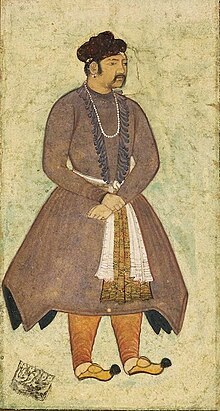Jalaluddin Mohammad Akbar
| Akbar | |||||
|---|---|---|---|---|---|

Late 16th century portrait of Akbar by Manohar
|
|||||
| 3rd Mughal Emperor | |||||
| Reign | 14 February 1556 – 27 October 1605 | ||||
| Coronation | 14 February 1556 | ||||
| Predecessor | Humayun | ||||
| Successor | Jahangir | ||||
| Regent | Bairam Khan (1556–1561) | ||||
| Born | Jalal ud-Din Muhammad 15 October 1542 Umerkot, Rajputana (present-day Sindh, Pakistan) |
||||
| Died | 27 October 1605 (aged 63) Fatehpur Sikri, Agra, Mughal Empire (present-day Uttar Pradesh, India) |
||||
| Burial | Sikandra, Agra | ||||
| Consort | Ruqaiya Sultan Begum | ||||
| Wives |
Salima Sultan Begum Mariam-uz-Zamani Qismiyah Banu Begum Bibi Daulat Shad Raziya Sultan Begum Rajkumari Rukmawati Baiji Lal Baiji Lal Bhanumati Kanwari Baiji Lal Raj Kanwari Maharajkumari Nathi Bai Tara Begum Sahiba Tauti Begum Rajkumari Manbhaoti |
||||
| Issue | Hassan Hussain Jahangir Murad Daniyal Aram Banu Begum Shakr-un-Nissa Begum Khanum Sultan Begum |
||||
|
|||||
| House | House of Timur | ||||
| Father | Humayun | ||||
| Mother | Hamida Banu Begum | ||||
| Religion | Islam (Sunni), Din-e-Illahi | ||||
| Full name | |
|---|---|
| Abu'l-Fath Jalal ud-din Muhammad Akbar |
Abu'l-Fath Jalal ud-din Muhammad Akbar, popularly known as Akbar I (IPA: [əkbər], literally "the great"; 15 October 1542– 27 October 1605) and later Akbar the Great (Urdu: اکبر اعظم; literally "Great the Great"), was Mughal Emperor from 1556 until his death. He was the third ruler of the Mughal Dynasty in India. Akbar succeeded his father, Humayun, under a regent, Bairam Khan, who helped the young emperor expand and consolidate Mughal domains in India. A strong personality and a successful general, Akbar gradually enlarged the Mughal Empire to include nearly all of the Indian Subcontinent north of the Godavari river. His power and influence, however, extended over the entire country because of Mughal military, political, cultural, and economic dominance. To unify the vast Mughal state, Akbar established a centralised system of administration throughout his empire and adopted a policy of conciliating conquered rulers through marriage and diplomacy. To preserve peace and order in a religiously and culturally diverse empire, he adopted policies that won him the support of his non-Muslim subjects. Eschewing tribal bonds and Islamic state identity, Akbar strived to unite far-flung lands of his realm through loyalty, expressed through a Persianised culture, to himself as an emperor who had near-divine status.
Mughal India developed a strong and stable economy, leading to commercial expansion and greater patronage of culture. Akbar himself was a patron of art and culture. He was fond of literature, and created a library of over 24,000 volumes written in Sanskrit, Hindustani, Persian, Greek, Latin, Arabic and Kashmiri, staffed by many scholars, translators, artists, calligraphers, scribes, bookbinders and readers. Holy men of many faiths, poets, architects and artisans adorned his court from all over the world for study and discussion. Akbar's courts at Delhi, Agra, and Fatehpur Sikri became centres of the arts, letters, and learning. Perso-Islamic culture began to merge and blend with indigenous Indian elements, and a distinct Indo-Persian culture emerged characterised by Mughal style arts, painting, and architecture. Disillusioned with orthodox Islam and perhaps hoping to bring about religious unity within his empire, Akbar promulgated Din-i-Ilahi, a syncretic creed derived from Islam, Hinduism, Zoroastrianism, and Christianity. A simple, monotheistic cult, tolerant in outlook, it centred on Akbar as a prophet, for which he drew the ire of the ulema and orthodox Muslims. Many of his courtiers followed Din-i-Ilahi as their religion as well, as many believed that Akbar was a prophet. One famous courtier who followed this blended religion was Birbal.
...
Wikipedia
